Ultimate guide to visiting Arcos de la Frontera, one of the most dramatically positioned white villages in Cadiz province Andalucia
By Liza S. | Updated 16 Oct 2023 | Cádiz | Villages |
Login to add to YOUR Favourites or Read Later
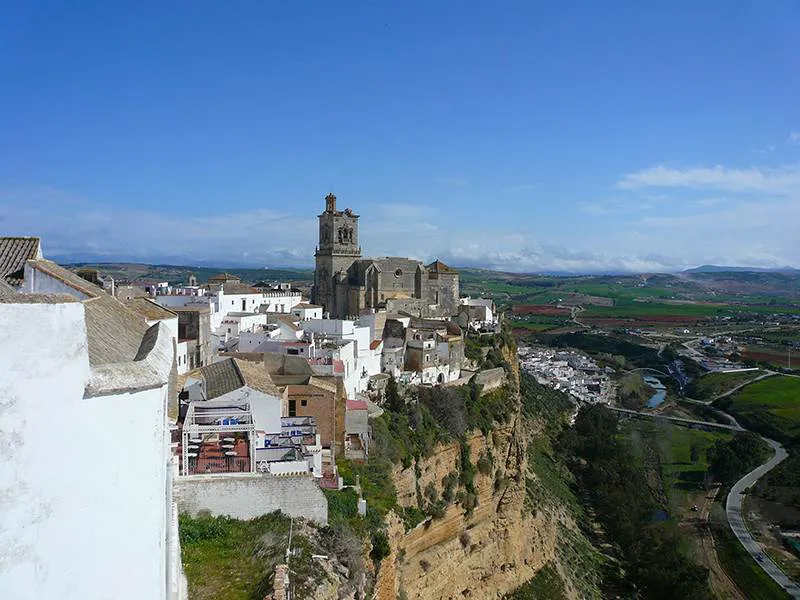
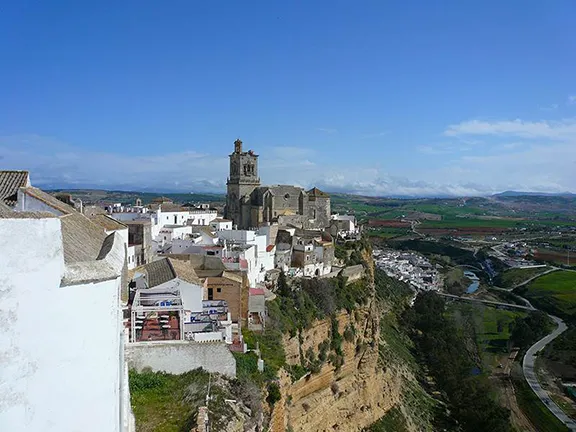
Arcos de la Frontera
If you're looking for a charming and picturesque town to visit in Andalucia, look no further than Arcos de la Frontera. Perched on a 150 metre high limestone ridge overlooking the river Guadalette, Arcos de la Frontera is one of the most dramatically positioned white villages in Andalucia.
This hilltop town is one of the famous "pueblos blancos" (white towns) of Spain, known for their whitewashed buildings and narrow, winding streets. Arcos de la Frontera is a perfect destination if you’re interested in history, culture, and natural beauty.
In this article, you’ll discover the beauty of this lovely white village in Andalucia and get all the essential information you need to plan your visit.
Arcos de la Frontera, as it was then known, was ceded to the estate of Ruy Lopez de Avila in 1408 and then became part of the massive estates owned by the house of Ponce de León in 1440.
During the War of Succession, (1701 – 1714) between Spain and France and Great Britain and the Holy Roman Empire, Arcos supported the ascendancy to the Spanish throne of Philip of Anjou who eventually became Philip V of Spain. As a gesture of thanks, Philip awarded Arcos de la Frontera the title, ‘noble and most faithful town’.
During the War of Independence (1807 – 1814), France was the belligerent party and the United Kingdom were Spanish allies. Despite heroic resistance, Arcos was occupied by French troops of Napoleon Bonaparte’s army between 1810 and 1812. Such was the balance of power politics in Europe between the 18th and 20th centuries.
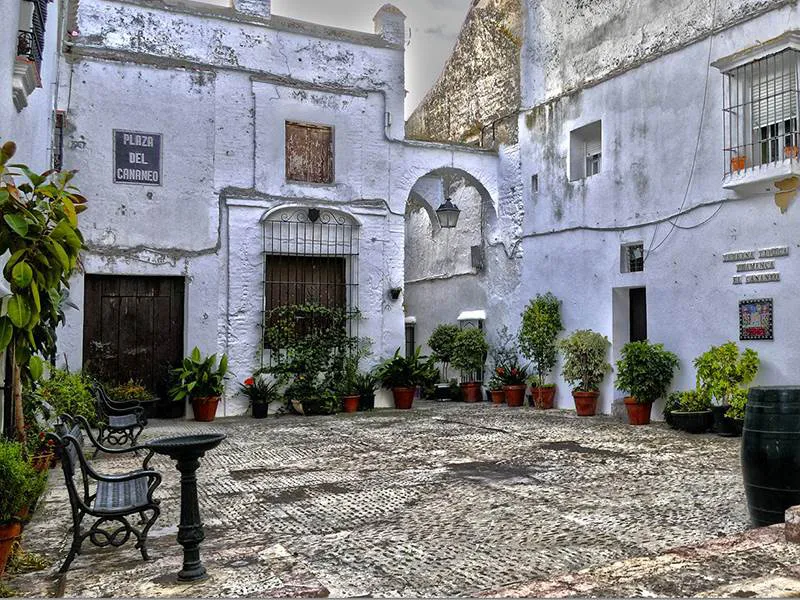

Old Town of Arcos de la Frontera
Located in the province of Cadiz, Arcos de la Frontera is one of the most picturesque and historic places in the region. However, it is often overlooked in favour of bigger and well-known cities like Seville and Cadiz and even among the white villages, it isn’t as well-known as towns such as Ronda and Setenil de las Bodegas.
That said, in my opinion, it’s absolutely worth visiting Arcos de la Frontera. I was blown away by how beautiful and charming this town is when I visited!
One of the main reasons to visit Arcos de la Frontera is its stunning location. The town is perched on top of a rocky hill, overlooking the Guadalete River. The views from the town are simply breathtaking, and you can see for miles around. The town's location also means that it has a rich history, as it has been inhabited since prehistoric times.
Another reason to visit Arcos de la Frontera is its beautiful architecture. The town is full of narrow streets and whitewashed houses, which are typical of the Andalucian style. There are also many historic monuments to see such as the Castle of Arcos de la Frontera, the Church of San Pedro, and the Convent of San Agustin.
If you are interested in culture and history, you will find plenty to keep you busy in Arcos de la Frontera. The town has a rich cultural heritage, and there are museums and galleries to explore. You can also attend concerts and festivals throughout the year, which showcase the town's traditions and customs.
Finally, Arcos de la Frontera is a great place to relax and unwind. The town has a laid-back atmosphere, and there are many parks and gardens where you can enjoy a picnic or a stroll. You can also sample the local cuisine, which includes delicious seafood and tapas dishes.
With its stunning location, beautiful architecture, rich culture, and relaxed atmosphere, Arcos de la Frontera is the perfect place to experience the best of southern Spain.
The best way to visit Arcos de la Frontera is on a day trip. You can visit it as a standalone day trip or as one stop on a tour of selected white villages. This works best if you’re based in Seville or Cadiz as these are the two major cities closest to Arcos de la Frontera.
You can also visit Arcos de la Frontera if you’re travelling between Seville and Cadiz as it’s along the route (with a slight detour, but it’s worth it). I myself visited Arcos de la Frontera on the way from Seville to Cadiz; it was a great way to break up the drive and see a lovely town!
It’s most convenient to visit Arcos de la Frontera by car but if you prefer to sit back and relax, there are guided tours of the white villages that include a stop in Arcos de la Frontera:
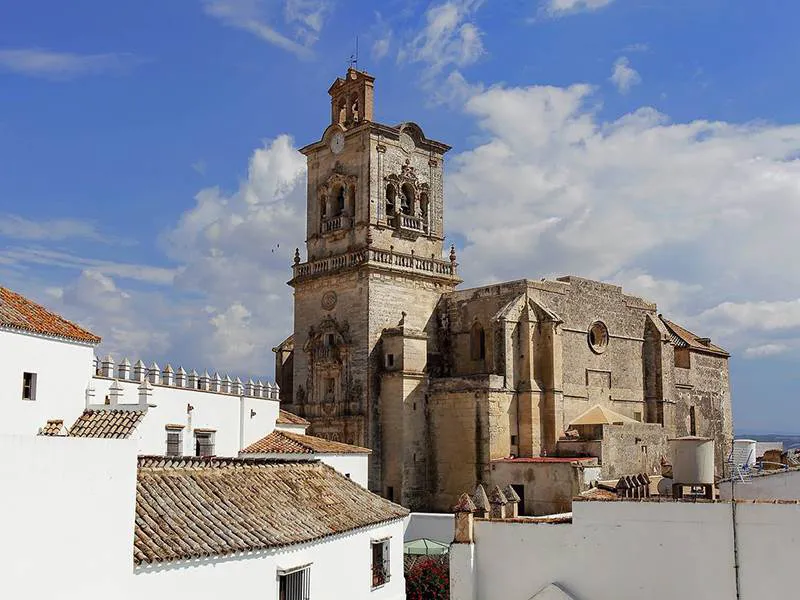

Iglesia de San Pedro
Getting to Arcos de la Frontera is easy and convenient. You can reach this beautiful town by train, bus, or car. Here's how to get there.
The nearest train station to Arcos de la Frontera is located in Jerez de la Frontera, which is about 30 kilometres away. From there, you can take a local bus or hire a taxi to reach Arcos de la Frontera. The journey takes around 30 minutes and offers stunning views of the countryside.
Click here to check the Jerez-Arcos bus schedule.
There are several bus companies that operate services to Arcos de la Frontera from major cities in Andalucia, including Seville, Cadiz, and Malaga. The bus station is located in the lower part of town so if you’re staying in the Old Town and travelling with luggage, you may need to take a taxi.
I like using Omio to check the best routes and compare prices to find what best suits my needs. Simply input your travel dates below to plan your trip to Arcos by train or bus!
If you're driving to Arcos de la Frontera, take the A-382 road that connects Jerez de la Frontera and Antequera. The journey takes around 30 minutes from Jerez de la Frontera, under an hour from Cadiz, and around 2 hours from Seville.
To get to the town, get off the highway on the first exit (West Exit or Salida Oeste) that will take you to the main entrance of the city.
Upon arriving in Arcos, it’s best to park outside of the Old Town. There is a free open-air parking space at Avda. Duque de Arcos (click here for Google Maps location). From here, take the free bus to the monuments area (frequency: every 30 minutes). You can also choose to walk and it will take about 15-20 minutes (do note that you’ll be walking uphill).
There is also a paid parking lot at Paseo de Andalucia (click here for Google Maps location). From here, it’s a short walk to Plaza Espana where you can catch the above-mentioned free bus. If you choose to walk, it’s about 10 minutes by foot from Plaza Espana to the monuments area.
Arcos de la Frontera is a town steeped in history and culture, with a wealth of historical landmarks to explore, cultural experiences, as well as outdoor activities.
The tourist office that occupies part of the 17th century town hall is a good place to start a tour of historical Arcos. Do not miss the portrait of King Charles III within the town hall. It is attributed to Goya. The whole of the town centre of Arcos de la Frontera was declared a Monument of Historical and Artistic Importance in 1962.
If you're arriving in the morning, I highly recommend taking this walking tour of Arcos. This 1.5-hour tour begins at 11.00am and with a local guide at the helm, you'll get a superb introduction to the town's history and sights.
Here are our picks for the best things to do and see in Arcos de la Frontera.
Plaza del Cabildo is the beating heart of Arcos de la Frontera, often considered the town's most iconic spot.
Nestled in the town's old quarter, the plaza boasts the remarkable Santa María Basilica and offers direct access to the Castillo de Arcos. Apart from soaking in the splendid architecture, you can also enjoy local cafés that line the square, offering traditional Andalucian delicacies.
One of the plaza's highlights is the viewpoint, which presents unparalleled panoramic views of the Guadalete River and the Andalusian countryside.
The old white village clusters around the castle, Castillo de los Arcos, at the highest part of the ridge.
The original castle was built in the 11th century. What you see today is largely the 15th century rebuild and it is privately owned. An abrupt cliff descends sheer to the valley below affording splendid views over the orange and olive groves that cover the plains either side of the Guadalette.
To reach the castle and its views, you must first negotiate the winding alleys, many with arches, that make up the Moorish part of the town. Drivers, you’re advised to leave your cars at the bottom of the ridge - these alleys were only ever meant for mules.
Castillo de Arcos is only open to the public 4 days a year. In 2023, these are the dates it is open:
Even if you’re visiting on any other day, it’s still worth passing by the castle to admire its exterior.
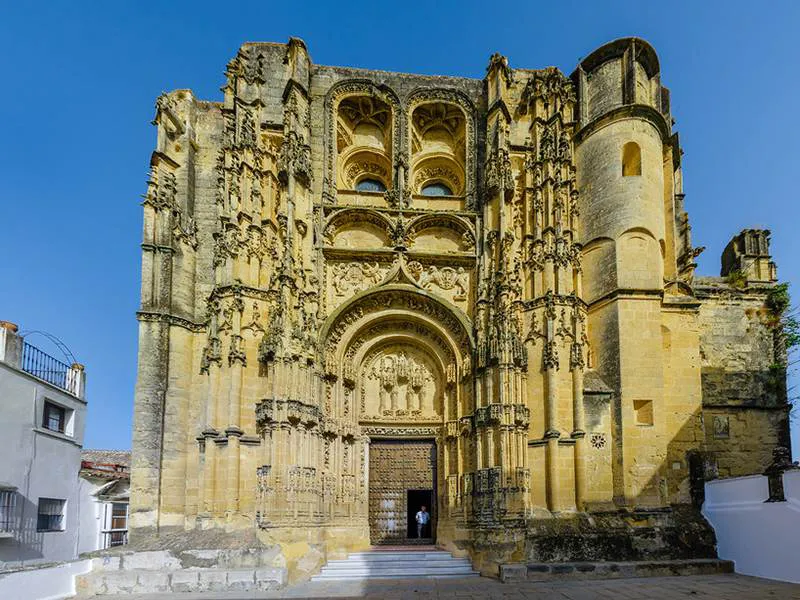

Basilica de Santa Maria
Medina Ar-kotsch was an important frontier town between the Moslem territories and the Christians. It was eventually captured by the Christians in 1250 and came under the control of Ferdinand III. Fourteen years later, the Moslem inhabitants, who had been allowed to remain, revolted and they were expelled by decree of Alfonso X in 1264.
The Gothic Cathedral on top of the ridge, the Basilica de Santa Maria de la Asunción, dates to this period. The cathedral has ten bells that, famously, continued ringing throughout the Moorish revolt. It is built on top of a Visigothic temple that in turn lies below a 13th century mosque.
Today, the basilica is one of the most important religious buildings in the town, and its impressive facade and ornate interior make it a must-visit for anyone interested in architecture or history.
Other religious buildings in Arcos de la Frontera testify to its importance as a citadel.
The Iglesia de San Pedro was built between the 15th and 17th centuries on the site of a 14th century watchtower and features a mix of Gothic and Baroque architectural styles. The church is home to a number of important religious artworks, including a stunning altarpiece.
Formerly a Moorish fortress, Iglesia de San Miguel is a striking example of Gothic and Baroque architectural styles. This church, with its ornate façade and impressive tower, offers visitors panoramic views of the surrounding landscape from its vantage point atop the cliffside.
Palacio del Mayorazgo stands as a testament to the opulence and grandeur of Arcos de la Frontera's past.
Located close to the town's main thoroughfares, this stately mansion showcases exquisite Renaissance architecture. Its façade, adorned with intricate stonework, offers a glimpse into the artistic prowess of yesteryears. Inside, you can admire the elegantly appointed rooms and courtyards, reminiscent of the aristocratic lifestyles of its former inhabitants.
A notable feature is its collection of historic artefacts and artworks that paint a vivid picture of Andalucian nobility. A visit to Palacio del Mayorazgo is a journey back in time into Arcos' noble heritage.
Mayorazgo Palace has quite specific opening hours so be sure to time your visit carefully:
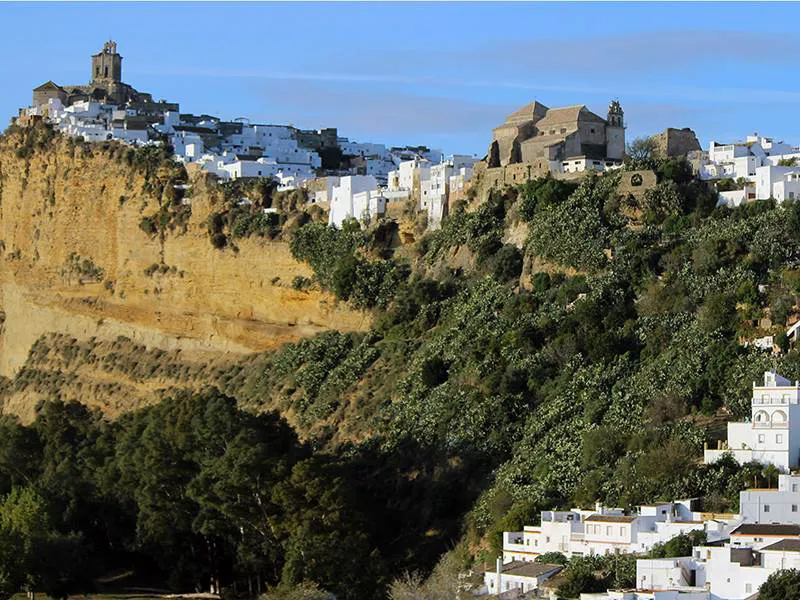

Arcos de la Frontera, perched on a cliff
The Convento de las Mercedarias Descalzas is a significant 17th-century landmark in Arcos de la Frontera. With its blend of Gothic and Baroque architecture, it stands as a representation of Andalucian religious structures. And its central location in Arcos and free entry makes it easy for tourists to drop by.
While the convent is home to cloistered nuns, its church is accessible to visitors. Step inside to view its fascinating array of religious art and impressive altar pieces. A visit here will give you insight into the town's religious history and a chance to appreciate the preserved architecture of the period.
As Arcos de la Frontera is perched atop a limestone ridge, it’s no surprise that it’s well-known for its breathtaking viewpoints, or "miradors." These vantage points offer sweeping vistas of the Guadalete River, rolling Andalucian hills, and the town's distinctive white-washed buildings.
So, of course, visiting the town’s best miradors is a must on your visit!
Visiting one (or all!) of these miradors is an essential activity in Arcos de la Frontera. (Yes, I did visit all three of them on my short visit…)
Barrio Bajo is the lower part of Arcos de la Frontera, distinct from the elevated old town. Characterised by its narrower streets and more modern feel, it's a lively area where locals and tourists mingle.
Here, visitors can experience a slice of everyday life in Arcos. The neighbourhood is dotted with numerous shops, tapas bars, and restaurants, offering authentic Andalucian cuisine. Its proximity to the river adds to the charm, making it a pleasant spot for a riverside stroll.
If you have more time in Arcos, I definitely recommend venturing into Barrio Bajo for a less touristy, more local experience, and to enjoy the vibrant atmosphere it offers.
If you don’t manage to go to a flamenco show in the bigger Andalucian cities, Arcos de la Frontera is a great place to experience it.
You can find flamenco shows in various venues throughout the city, including bars, restaurants, and theatres. Some of the most famous flamenco artists in Spain have performed in Arcos de la Frontera, and the city is known for its vibrant and passionate flamenco scene.
One place to check out is Tablao Flamenco Los Molinos which is known for offering authentic flamenco performances in an intimate setting.
Arcos de la Frontera is home to several local festivals that celebrate the city's cultural heritage.
The most famous of these is the Feria de San Miguel, which takes place in late September. During the festival, the city comes alive with music, dancing, and traditional food and drink. You can also see bullfights and other traditional events during the festival.
Another popular festival is Semana Santa, which takes place in the week leading up to Easter. During this time, the city is filled with religious processions and other events that celebrate the city's Catholic heritage.
If you're interested in history and culture, these festivals are a great way to experience the unique traditions and customs of Arcos de la Frontera.
Arcos de la Frontera is a great destination for outdoor enthusiasts. The town is surrounded by stunning natural landscapes, making it the perfect place to enjoy outdoor activities. So if you decide to stay a night or two here, Arcos de la Frontera has some fantastic hiking routes to occupy your days.
The Sierra de Grazalema Natural Park is located nearby and offers some of the most beautiful hiking trails in the region. You can explore the park's rugged terrain, mountain ranges, and lush forests. The park has a variety of trails that range from easy to difficult, so there is something for everyone.
Some of the most popular hiking routes include the Garganta Verde, El Torreon, and Salto del Cabrero.
For a unique outdoor activity, check out this horseback riding excursion.
Explore the picturesque surroundings of Arcos de la Frontera from the back of a well-trained horse. Riders of all levels, from beginners to seasoned equestrians, can partake in this adventure. As you traverse gentle trails, you'll be enveloped by the region's natural beauty, from rolling hills to verdant meadows and the distant silhouette of the town.
Accompanied by knowledgeable guides, this horseback riding experience is not only a journey through the landscape but also an insight into local equestrian traditions.
Arcos de la Frontera is a paradise for bird watchers.
The town is located in the heart of the Sierra de Grazalema Natural Park, which is home to a diverse range of bird species. You can spot birds such as the Griffon Vulture, Golden Eagle, and Peregrine Falcon. The park also has several bird watching spots, including the Mirador del Puerto de las Palomas and the Mirador del Estrecho.
Arcos de la Frontera has some of the best golf courses in the region. The town's mild climate makes it a perfect destination for golfers all year round.
If you’re keen on some golfing, the Arcos Gardens Golf Club is one of the best golf courses in the area. The course is set in stunning surroundings, with views of the countryside and the town of Arcos de la Frontera. The club also has a driving range, putting green, and a pro shop.
If you're looking for a culinary adventure in Arcos de la Frontera, you're in luck. This charming Andalucian town is home to a variety of delicious restaurants, tapas bars, and local wineries that are sure to tantalise your taste buds.
Here are some recommendations for where to eat in Arcos de la Frontera.
One of the best ways to experience the local cuisine is by visiting a traditional tapas bar. These small, casual establishments serve a variety of small plates, or tapas, that are perfect for sharing with friends.
Here are a few of our favourite tapas bars in Arcos de la Frontera:
Arcos de la Frontera is located in the heart of the sherry triangle, which means that there are plenty of local wineries to explore. Here are a few of our favourite wineries in the area:
The town is known for its local artisan shops and farmers' market. Here are some shopping options you should check out during your visit to Arcos de la Frontera.
The town is home to many local artisan shops where you can find unique handmade items. These shops offer a range of products such as ceramics, jewellery, leather goods, and textiles.
One of the most popular artisan shops in Arcos de la Frontera is La Tienda de Lola. Here, you can find beautiful handcrafted ceramics, textiles, and other unique items.
Another great artisan shop is La Casa de las Cabezas. This shop is located in a historic building and offers a wide range of handmade items such as ceramics, leather goods, and textiles. You can also find traditional Andalucian products such as olive oil and sherry.
The weekly farmers' market is held every Thursday in Plaza del Cabildo. Here, you can find fresh produce such as fruits, vegetables, and herbs. You can also find local products such as honey, cheese, and cured meats. The market is a great place to experience the local culture and taste the fresh and delicious food.
In addition to the farmers' market, there are also many small shops and markets throughout the town where you can find local products such as olive oil, wine, and cheese.
While most people visit Arcos de la Frontera on a day trip, if you’re looking for a tranquil and charming town to stay in, you may want to consider staying here. Whether you prefer a historic inn or a modern hotel, there are accommodations available to fit your needs and budget.
For a truly authentic experience, consider staying at one of the many historic inns in Arcos de la Frontera. These charming and quaint establishments offer a glimpse into the town's rich history and culture.
For an unforgettable experience, stay at Parador de Arcos de la Frontera, a former castle that has been converted into a luxury hotel. Located in the heart of the old town, the Parador offers stunning views of the surrounding countryside and the Guadalete River.
Other top historic stays in Arcos include Casa Campana, La Casa Grande, and Hotel El Convento.
If you prefer more modern accommodations, there are several hotels in Arcos de la Frontera that offer all the amenities you need for a comfortable stay.
One popular option is the Hotel Los Olivos, which features an outdoor pool, a restaurant, and free Wi-Fi. Another option is the Hotel La Fonda del Califa, which offers stylish rooms and a rooftop terrace with panoramic views of the town.
Other great modern hotels in the town include Hotel Marqués de Torresoto, Mesón de la Molinera, and Hotel Peña de Arcos.
Booking last minute or simply looking for a deal? Check out the latest deals in Arcos below! Booking.com
No matter where you choose to stay in Arcos de la Frontera, you're sure to enjoy the town's rich history, stunning architecture, and breathtaking views.
What are some must-see attractions in Arcos de la Frontera?
Arcos de la Frontera is a beautiful town with plenty of attractions to see. Some of the must-see attractions include the Castle of Arcos de la Frontera, the Basilica Menor de Santa Maria de la Asuncion, and the Plaza del Cabildo. You can also take a scenic walk along the route of the viewpoints to enjoy the stunning views of the town.
What are the best scenic walks in Arcos de la Frontera?
Yes, there are several scenic walks that you can take in Arcos de la Frontera. One of the most popular walks is the route of the viewpoints, which offers breathtaking views of the town. You can also take a walk along the Cuesta de Belen to see the beautiful white houses of the town.
Where is the best place to park in Arcos de la Frontera?
If you're driving to Arcos de la Frontera, it's best to park your car in a parking garage that's located outside the old town. One of the cheapest parking garages is located only a 15-minute walk from the old town. It's important to wear comfortable shoes as the walk is uphill.
What is the history behind the castle in Arcos de la Frontera?
The Castle of Arcos de la Frontera has a rich history that dates back to the 11th century. It was built by the Moors and later conquered by the Christians. The castle was used as a fortress during the War of Independence and was occupied by French troops between 1810 and 1812. Today, the castle is a popular tourist attraction and offers stunning views of the town.
Is Arcos de la Frontera worth visiting for a day trip?
Yes, Arcos de la Frontera is definitely worth visiting for a day trip. The town is known for its beautiful architecture, stunning views, and rich history. You can spend the day exploring the town's attractions, taking scenic walks, and enjoying the local cuisine.
What are some unique things that Arcos de la Frontera is known for?
Arcos de la Frontera is known for its beautiful white houses, stunning views, and rich history. The town is also known for its delicious local cuisine, which includes dishes like gazpacho, salmorejo, and pescaíto frito. Additionally, Arcos de la Frontera is known for its traditional festivals, such as the Feria de San Miguel and Semana Santa.
Interested in visiting more white villages in Andalucia on your trip? Here are some of our favourites.
Travelling to/around Spain and need some help? Here are our favourite travel resources.
We usually use Booking.com to look for hotels or apartment rentals. Lots of choice & you can unlock more discounts with their Genius loyalty programme!
To research transportation options around Spain, we like using Omio. It’s an easy way to compare different modes of transport and prices in one place.
For last-minute holiday deals, check out Expedia UK.
Looking for things to do? Viator has a huge catalog of activities and tours across many cities in Spain. We also love Get Your Guide!
Guruwalk is our favourite platform to find the best free walking tours in a city.
For money transfers or spending overseas in foreign currency, Wise is our favorite borderless banking service.
Travel insurance is a must to protect against emergencies and unexpected incidents. Get a quote from SafetyWing here.